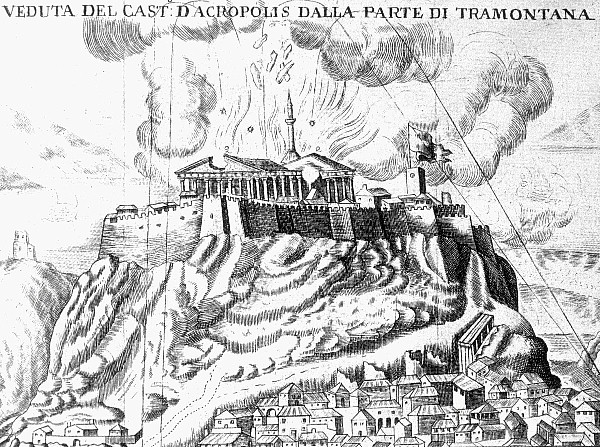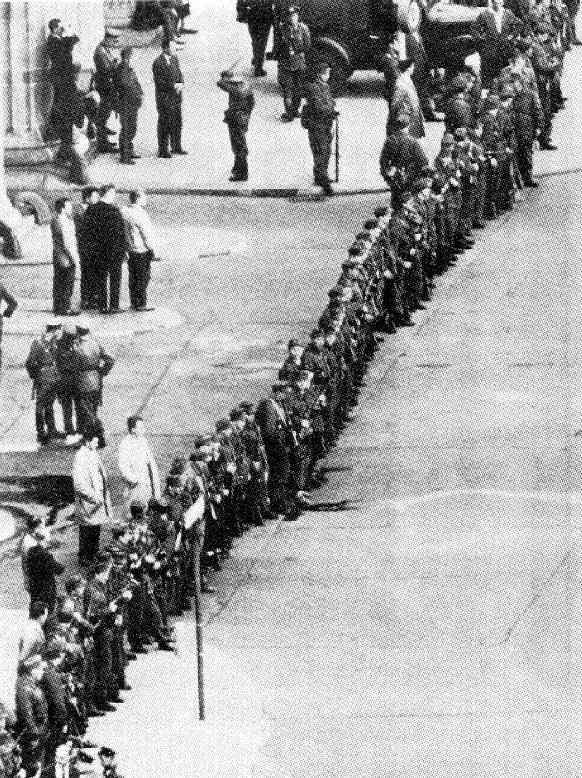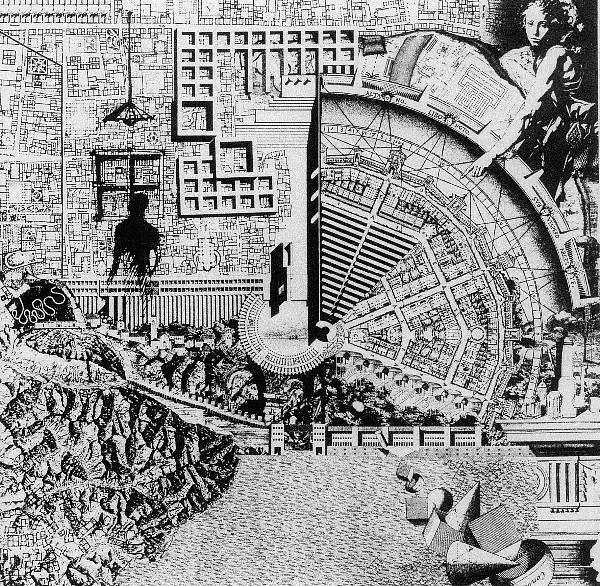
1687 explosion of the Parthenon

1961.08.13
| |

Aldo Rossi, La Cittą Analoga, 1976.
1997.09.07
Diana/Triumphal Way
Just two days (Thursday) before Diana's funeral service, I came across an article on the Triumphal Way in Ancient Rome. I found it in the first issue of Ritual, which I have owned since it came out in 1983. I was not mindful of the essay's existence, and I was happy to find it because of my current work regarding Piranesi' Campo Marzio which has the route of the Triumphal Way demarcated within it.
I read and finished the essay between late Thursday night and late Friday night. It addresses the notion of the elusive Triumphal Arch and the meaning of the passage of the Triumphator into the city, and then through the city. It also spoke of the monuments that were passed-by in the course of the procession, and how they were, over time, steadily incorporated into the ritual. It also spoke of how the crowds were an integral part of the procession and ritual--manifestation of the social mirror, the reflective lens of the "see and be seen" phenomena.
Mere hours after having finished the essay I was watching Princess Diana's funeral service. I turned on the television just as Earl Spencer, Prince William, Prince Harry, Prince Charles, and Prince Philip joined the procession at Buckingham Palace, taking their place behind Diana's coffin. As the procession made its way to Westminster Abbey, the television commentators called out the various monuments and landmarks: Victoria Fountain, Hyde Park, the Lutyen's Cenotaph at Whitehall. When I saw the coffin pass through the arch at xxx, however, I realized that I was indeed witnessing Diana's Triumphal Way.
| |
1998.09.11 10:06
big sign now gone
With all the recent discussion here regarding Venturi, signage, semiotics, etc., I thought it worthwhile mentioning that the Venturi, Rauch & Scott Brown big BASCO building sign (in Northeast Philadelphia) is now gone. The demolition (which is what I assume happened) occurred fairly recently.
The building was bought by BEST soon after BASCO "built" the sign in the early eighties. Since BEST went out of business in the early nineties, the building and its big alphabet sign have been derelict.
It is indeed sad to see such a perfect example of "theory into practice" architecture relegated to the virtual existence of photographs.
Perhaps one lesson to learn here is that whenever architectural design is so closely tied to commercialism and consumerism, then its fate as something fleeting is almost guaranteed.
1998.10.29 10:08
what's fire?
With regard to architectural theory and lighting, I'm curious as to whether fire is considered natural illumination or artificial illumination.
When I went to architectural school in the late 1970s, natural lighting was the sunlight/daylight that came through windows, and electrical lighting was called artificial lighting. There was never any discussion as to the place of fire as illumination, even though for the greater part of architectural history fire was the only other means of illumination excepting light from the sun.
1998.11.16 10:03
phase1.1?
...the space station fits precisely within the realm of extremity architecture. No question the space station is essentially as extreme as architecure can be today.
1998.12.17 14:45
Re: city making and city breaking
It has not escaped my attention that Operation Desert Fox has spurred some discussion here within the design-list that very much resembles the notion of humanity presently working metabolically, i.e., equal doses of creation and destruction. With regard to what I last said here concerning the possible notion of an assimilating architecture, my further elaboration of there presently also being an imaginative operation with a metabolic nature now seems very timely. I thus wish to interject one example of metabolic architecture/urbanism.
Berlin: foremost metabolic city of the 20th century
No doubt the city of Berlin, Germany has undergone unequaled metamorphosis throughout the course of the 20th century.
Berlin reached one of this planet's highest levels of urban density within the first quarter of this century.
In the 1930s, Berlin became capital of the National Socialist's Third Reich, an unprecedented create/destroy political machine, extreme even in its assimilation, the Holocaust purge.
1945, the Battle of Berlin leaves the city all but totally destroyed.
During the Cold War, Berlin increasingly becomes a very real duality, a duality much like metabolism itself.
1989, the Berlin Wall opens, falls, and within a few years the city is again united.
Y2K, Berlin begins the 21st century as a completely new German capital.
The pattern of creation and destruction completely pervades the last 100 years of Berlin's history, but then again it is also the capital of one of the 20th century's foremost metabolic nations.
Berlin and Germany are not alone in their metabolism, however. One only has to look at Japan and its two A-bomb cities, the two Koreas, the once two Vietnams, and there is always Israel and Old Jerusalem.
No one has yet suggested the likelihood of two Iraq's and/or two Baghdads, but it wouldn't surprise me in the least if that place somehow became very metabolic as well.
|